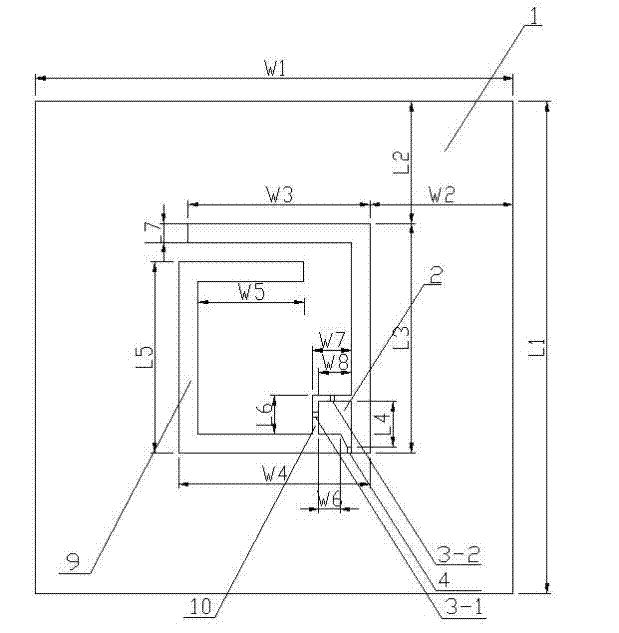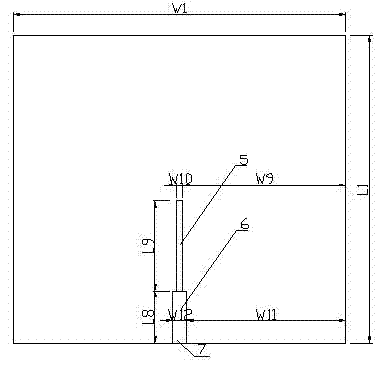Novel dual-frequency and polarization reconfigurable antenna
A technology for reconfiguring antennas and frequencies. It is applied to antennas, slot antennas, and devices that enable antennas to work in different bands at the same time. It can solve the problems of a large number of antennas, increased equipment volume, and low spectrum utilization. The effect of simplification, meeting transmission requirements, and wide impedance bandwidth
- Summary
- Abstract
- Description
- Claims
- Application Information
AI Technical Summary
Problems solved by technology
Method used
Image
Examples
Embodiment 1
[0032] see Figure 1~Figure 3 , the new dual-frequency frequency and polarization reconfigurable antenna, including a three-layer structure: the front is two metal layers (1, 2), DC blocking capacitor (3) and RF PIN diode (4), and the middle is a dielectric substrate (8) and SMA connector (7), the back of the dielectric substrate is a metal feeder (5, 6), which is characterized in that a square spiral large slit (9) is etched on the entire metal surface to form two large and small metal layers (1, 2), use the large gap as the radiation part of the antenna, and load the RF PIN diode (4) on the large gap (9) between the two metal layers (1, 2) on the front and the small gap (10) Capacitors (3-1, 3-2) are loaded on top to enable the antenna to obtain a reconfigurable function of frequency and polarization.
Embodiment 2
[0034] This embodiment is basically the same as Embodiment 1, and the special features are as follows:
[0035] The position of the diode (4) enables the antenna to obtain good impedance matching and larger bandwidth when operating at 1.6GHz and 3.0GHz.
Embodiment 3
[0037] figure 1 It is the front view of this embodiment, which is composed of a metal layer, a radio frequency PIN diode and a DC blocking capacitor; figure 2 It is the rear view of this embodiment, which is composed of metal feeders; image 3 It is the dielectric plate layer used in this embodiment, and its thickness is H. The dimensions of this antenna structure are as follows:
[0038] L1=100mm, L2=23.5mm, L3=49mm, L4=8mm, L5=41mm, L6=6mm, L7=4mm, L8=22mm, L9=22.4mm
[0039] W1=100mm, W2=27mm, W3=42mm, W4=45mm, W5=27mm, W6=2.5mm, W7=6mm, W8=5mm, W9=49mm, W10=2mm, W11=48.2mm, W12=3.6mm
[0040] H=0.8mm.
[0041] The antenna has an asymmetric structure, and the feeder (5) and the feeder (6) constitute the microstrip feeder of the coplanar waveguide. In the two operating frequency bands, the characteristic impedance of the feeder is approximately equal to 50 ohms, so that better impedance matching can be obtained between the feeder and the port metal layer (6) connected ...
PUM
| Property | Measurement | Unit |
|---|---|---|
| Thickness | aaaaa | aaaaa |
Abstract
Description
Claims
Application Information
 Login to View More
Login to View More - R&D
- Intellectual Property
- Life Sciences
- Materials
- Tech Scout
- Unparalleled Data Quality
- Higher Quality Content
- 60% Fewer Hallucinations
Browse by: Latest US Patents, China's latest patents, Technical Efficacy Thesaurus, Application Domain, Technology Topic, Popular Technical Reports.
© 2025 PatSnap. All rights reserved.Legal|Privacy policy|Modern Slavery Act Transparency Statement|Sitemap|About US| Contact US: help@patsnap.com



